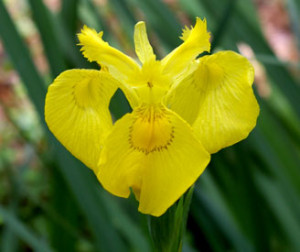My county has some of the loveliest public parks around, with long, winding roads, beautiful trees and winsome water features. The paths through these parks are among my favorite walking routes. I was out walking not long ago and spotted a clump of yellow flag iris or Iris pseudacorus on the edge of a large, man-made pond. The plants were perfectly positioned, leaning out from the bank so that the golden yellow flower petals were reflected in the water. Clearly the clump of yellow flag was waiting for Monet, or someone like him, to come and immortalize it.
May is iris time, when iris of all types—slender Siberians, statuesque “German” or garden specimens, and the wonderful Iris pallida, with its striped leaves and pale blue flowers—all come into bloom. The yellow flag iris was right on schedule.
Yellow flags are tall, rising between three and five feet, and slender. Their long, blue-green leaves are erect and pointed at the tips. When the flowers form, they sit atop the stalks, each one with three upward-facing petals or “standards”, and three downward-facing petals or “falls”. Unlike some iris, the pseudacorus species does not have “beards” or fuzzy areas on the falls. Instead, yellow flag sports attractive brownish veins on the petals.
Despite its uncommon beauty, yellow flag iris is relatively common in the United States and Canada. It is an immigrant, native to Eurasia and northern Africa, and has been known and cultivated for centuries. According to legend, yellow flag was the original model for the fleur de lis, which became the emblem of the French monarchy. The iris crossed the pond early and caught on with plant lovers. Thomas Jefferson was growing it in 1767. Observant gardener that he was, Jefferson probably noticed the iris’ uncommon vigor. Plants that are situated in congenial conditions, which include sun to part shade and consistently moist soil, will spread quickly by way of underground rhizomes. The flowers also give way to large pods filled with seeds that can float easily in running water, sometimes for long periods, finally coming to rest on a patch of ground and germinating far from the mother plant.
Yellow flag is one of those “good news, bad news” species. In addition to being beautiful and hardy, its roots can absorb metals and may be able to remove heavy metals from wastewater. Massed on a slope, yellow flag also prevents erosion. Though the rhizomes are poisonous, nineteenth century scientists found that the roasted seeds could be used to produce an acceptable coffee substitute.
What made them try such a thing? Who knows? I would not recommend attempting to duplicate their experiments.
The bad news about yellow flag is that it is invasive in many parts of the United States, especially in the Northeast, Upper Midwest and Far West. When it grows by natural streams, lakes or rivers, it can form very large clumps, outcompeting native plants and even choking narrow waterways.
So while I love looking at the yellow flag iris in my local park, I will not try it at home. I will plant its relative, blue flag iris, the name given to plants of several similar native species found throughout the United States. In my part of the world, the most common blue flag is Iris versicolor, which boasts the same slender, elegant profile as yellow flag, without its invasive ways. Its parts are also somewhat toxic, which means that deer and other varmints avoid blue flag like the plague.
So if you have a damp spot on your property, or, better yet, a stream or water feature, run away from yellow flag iris and directly to blue flag iris. You can order plants from native plant vendor, New Moon Nursery, 910 Kings Highway Woodstown, NJ 08098; (888)-998-1951; www.newmoonnursery.com. Note that New Moon cannot ship to AK, AZ, CA, CO, ID, MT, NM, NV, OR, UT, TX, WA, WY, or Canada. In those areas, contact local native plant societies for in-state vendors.
